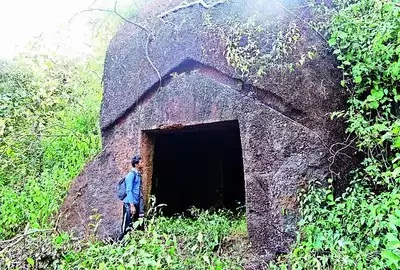Pangare Budruk, near Rajapur
This is a collection of articles archived for the excellence of their content. |
Introduction
Elevation of Pangare Budruk, Maharashtra, India
Location: India > Maharashtra > Ratnagiri >
Longitude: 73.5770801
Latitude: 16.6302518
Elevation: 155m / 509feet
Barometric Pressure: 99Kpa
Cave temple
2023
Oct 31, 2023: The Times of India

From: Oct 31, 2023: The Times of India
Navi Mumbai: A professor of ancient Indian history and his team of researchers have discovered two rock-cut Shaivite temple caves in a forested area near Rajapur, Ratnagiri, about 380km from Mumbai. Professor Dr Anjay Dhanawade (45) had first heard about these ancient monolithic rock-cut caves (with the Shivalings still existing) from villagers at Pangare Budruk in 2016 and started researching on this topic.
The elaborate thesis of Dhanawade and his team will soon be published in the Pune-based Deccan College bulletin.Talking to TOI, Dr Dhanawade said: “These rock-cut caves of the Shaiva sect are present around 8km from Rajapur town. A similar cluster of such Shaivite caves were earlier discovered in Cazule area of south Goa. The monolithic-cut laterite cave temple was created sometime around 5th or 6th century CE, and so are even older than the Elephanta caves. I find this to be a logical progression, because artisans used to build smaller rock cut cave temples, and later built the much grander Elephanta caves.”
Regional director of ASI in Mumbai, Dr K Lourdusamy, told TOI: “The study of monolithic rock-cut caves is always interesting. A grander version of such caves is also the famous Ellora Caves. ASI will inquire into the findings at Rajapur after the researchers contact us.”
We also published the following articles recently
A professor and his team of researchers have discovered two rock cut Shaivite caves near Rajapur, Ratnagiri district in India. The caves, believed to be from the 5th or 6th century CE, contain Shivalings and are older than the famous Elephanta caves. The findings will be published in the Deccan College Bulletin. The researchers plan to approach the Archaeological Survey of India to conduct further investigations at the site. The discovery sheds light on the history of the Konkan landscape.
Drought and high temperatures in Texas have caused water levels at Canyon Lake to drop, revealing submerged caves and 19th-century structures. The lake, originally built for flood control, is now at a record low level, approximately 18 feet below normal. While locals are excited about the historic ruins resurfacing, the diminishing water levels are a cause for concern. Recreational activities have been suspended due to the increased risks posed by underwater hazards such as tree stumps and rocks.
Residents in Pune were shocked to find that a portion of the road on the Chandni Chowk flyover had caved in. The flyover was inaugurated in August and has already suffered structural damage. Officials from the company building the flyover and the National Highway Authority of India (NHAI) arrived at the scene to investigate the issue. It was discovered that the bridge had no expansion joints, which may have caused the cave-in. Residents are concerned about the quality of the project and are calling for a full audit by a third-party agency.